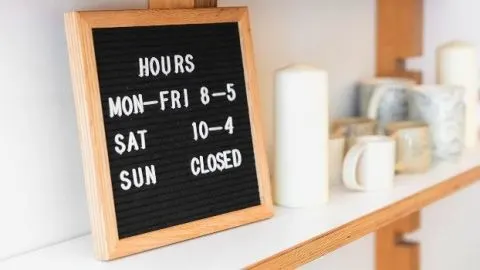In English speaking countries, some expressions are so ubiquitous that it seems you run into them everywhere you turn.
And, if you don’t know what they mean, you can be left scratching your head, feeling that there is some vital piece of information you’re missing out on.
One such expression is “opening hours.”
You see it on storefronts and you hear it on phone calls all the time.
In fact, it is such a vital part of life in an English country that it would be very difficult for you to carry out normal day-to-day activities, including buying bread from the store or making a deposit at the bank, without a thorough understanding of that phrase.
Moreover, there are a few other similar phrases, chief among which is “business hours.”
So, without further ado, let’s clear all this up.
What is the meaning of “opening hours”?
“Opening hours” are the hours during which a business is open. This business is usually a store, a library, or even a restaurant or bar. The opening hours will detail what times the business is open and which days. Ergo, opening hours let you know when a business can receive you and when you won’t be able to access their services.
This is why you are bound to find signs in front of different stores telling you their opening hours.
For example, you might see the following sign in front of your local bank.
It is worth noting, that in comparison to other establishments, banks tend to have very short opening hours.
Alternatively, you might come across the following sign hanging on your baker’s front door.
Opening Hours
Mon. 8 a.m.-9 p.m.
Tues. 8 a.m. – 9 p.m.
Wed. 8 a.m. – 9 p.m.
Thurs. 8 a.m. – 9 p.m.
Frid. 8 a.m. – 9 p.m.
Sat. 8 a.m. – 6 p.m.
Sun. 11 a.m. – 7 p.m.
There are other ways of displaying a place’s opening hours, but you should get the general gist by now.
“Opening hours” doesn’t just have to appear on signs. You can use it in a sentence.
Example
The spread of “opening hours”
Before moving on and looking at various alternatives, it is worth taking a moment to look at how “opening hours” spread throughout the English Language.
According to the Collins Dictionary, the usage of “opening hours” was relatively low and stable until the mid-1960s. However, after that, the word experienced a boom, and over the next 50 years, the word’s popularity increased tenfold.
On the other hand, looking at the Google Books Ngram Viewer, you will find that “opening hours” was relatively unpopular until the beginning of the 20th century.
But, over the last century, the word has become more than 30 times more popular than it was in the 1800s.
So, why is this interesting?
Because it marks a very interesting moment in our history.
You see, over the past two centuries, a lot has changed. The industrial revolution took hold of the world.
In fact, we are now on the cusp of the fourth industrial revolution. Capitalism beat out communism.
And, stores developed franchises, which means that your local grocer, probably a mom-and-pop shop, had to compete with large franchises and huge corporations.
While residents within a small town might have known when the grocer in question remained open, these same residents needed to be told when the new franchised store that just rolled into town would be available for business.
However, the most significant advance, at least for our purposes was the introduction of the 9-5 workday.
Even though the 9-5 workday was an invention brought about in the 1800s by American labor unions that wanted to ease working conditions for its members, it wasn’t until the 1920s that the eight-hour workday became mainstream thanks to Henry Ford.
With this in mind, it isn’t that much of a leap to see the relation between the institutionalization of the eight-hour workday and the spread of “opening hours.”
In fact, you will realize that for many establishments, including banks, the opening hours happen to coincide perfectly with said establishment’s working day.
Now, some people get confused about the meaning (and also the difference) between the terms “opening hours” and “open hours.”
This is why we are also going to have a quick glance at the less common “open hours.”
Let’s dive right into it.

What is the meaning of open hours?
“Open hours” refer to when a business is open and functioning. These tend to be service-oriented businesses that don’t have to physically receive customers. And, even when these non-commercial businesses do receive customers, they do so almost one at a time. For example, a counselor service at a university might let the students know that “open hours are from 9-5 Monday through Friday.”
Ergo, “open hours” is more similar to “business hours” than it is to “opening hours,” yet there are several circumstances where “business hours” would be appropriate and “open hours” wouldn’t be.
For example, if we go back to our customer service example, “open hours” would be completely inappropriate in this situation.
But what exactly are “business hours” exactly? Yet another rabbit hole to explore!
Similar phrases to “opening hours” & “open hours“
Here are a few other similar expressions.
”Business hours”
Rather than “opening hours,” you might have come across “business hours,” which left you wondering what’s the difference between the two.
On the one hand, the two kind of mean the same thing. “Business hours” are the times during which an establishment is in business. Nevertheless, there is a subtle difference.
“Opening hours” is used for stores and other places that receive customers. Hence, these places have to be open.
On the other hand, “business hours” is used to refer to establishments that perform services while not necessarily having to receive customers.
For instance, if you buy something off of an e-commerce site, but when you got the package, it wasn’t what was advertised on the site.
So, feeling cheated, you decide to contact the site’s customer service and complain about being slighted. As you look up the phone number for customer service, you might find the following message.
What this message is basically telling you is that customer service will be available to take your call during these business hours only. If you call outside these hours, you will probably be unable to reach any service agents.

Hey fellow Linguaholics! It’s me, Marcel. I am the proud owner of linguaholic.com. Languages have always been my passion and I have studied Linguistics, Computational Linguistics and Sinology at the University of Zurich. It is my utmost pleasure to share with all of you guys what I know about languages and linguistics in general.

